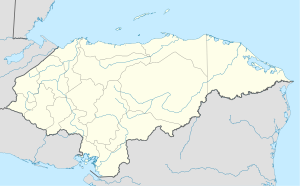| This article needs additional citations for verification. Please help improve this article by adding citations to reliable sources. Unsourced material may be challenged and removed. Find sources: "Talgua" – news · newspapers · books · scholar · JSTOR (January 2023) (Learn how and when to remove this message) |
| Talgua | |
|---|---|
| Municipality | |
 Panoramic View of Talgua Panoramic View of Talgua | |
 | |
| Coordinates: 14°42′N 88°42′W / 14.700°N 88.700°W / 14.700; -88.700 | |
| Country | Honduras |
| Department | Lempira |
| Area | |
| • Total | 82 km (32 sq mi) |
| Population | |
| • Total | 10,744 |
| • Density | 130/km (340/sq mi) |
Talgua (Spanish pronunciation: [ˈtalɣwa]) is a municipality in the Honduran department of Lempira.
History
| This section does not cite any sources. Please help improve this section by adding citations to reliable sources. Unsourced material may be challenged and removed. (January 2023) (Learn how and when to remove this message) |
Talgua was founded in the colonial period in the place called "Las Mercedes" village. Also it was known as a village where Lenca Indians dwelled, by Pedro de Alvarado and his troops. In the administration of president Ramon Villeda Morales, on January 2, 1963, the capital was moved from Talagua to San Antonio de Pedernales. The old church is preserved as a relic.

Geography
| This section does not cite any sources. Please help improve this section by adding citations to reliable sources. Unsourced material may be challenged and removed. (January 2023) (Learn how and when to remove this message) |
It is located right on top a small hill on the side of a river. But there are high mountains around its capital and some of these belong to Copán department. The weather is hot because of the elevation from sea level and the vegetation, which consists of dry sub tropical forest. Some pine trees are seen on the highest hills.
Boundaries
Its boundaries are:
- North : Copán department
- South : Las Flores municipality
- East : Las Flores municipality
- West : Copán department
- Surface Extents: 82 km
Resources
| This section does not cite any sources. Please help improve this section by adding citations to reliable sources. Unsourced material may be challenged and removed. (January 2023) (Learn how and when to remove this message) |
Talgua is of the poorest municipalities of the department. Due to its elevation from sea level is not possible to have coffee plantations, therefore the main economic activities are beans and corn crops, followed by commerce of groceries and other home supplies. Cattle raising is for local consumption only. Since it is near a river, some people obtain aggregates for concrete from it. Also it has electricity and mobile communication coverage.
Population
- Population: There were 8,399 people in 2001, and it is expected to have about 10,744 in 2015.
- Villages: 14
- Settlements: 50
Demographics
At the time of the 2013 Honduras census, Talgua municipality had a population of 10,420. Of these, 65.93% were Indigenous (65.81% Lenca), 27.12% Mestizo, 4.78% White, 2.16% Black or Afro-Honduran and 0.01% others.
Tourism
- Local Holidays: "Santa Cruz" day on May 3 and "San Francisco" day on October 4.
References
External links
| Lempira Department | ||
|---|---|---|
| Capital: Gracias | ||
| Municipalities |  | |
14°42′N 88°42′W / 14.700°N 88.700°W / 14.700; -88.700
This Honduras location article is a stub. You can help Misplaced Pages by expanding it. |